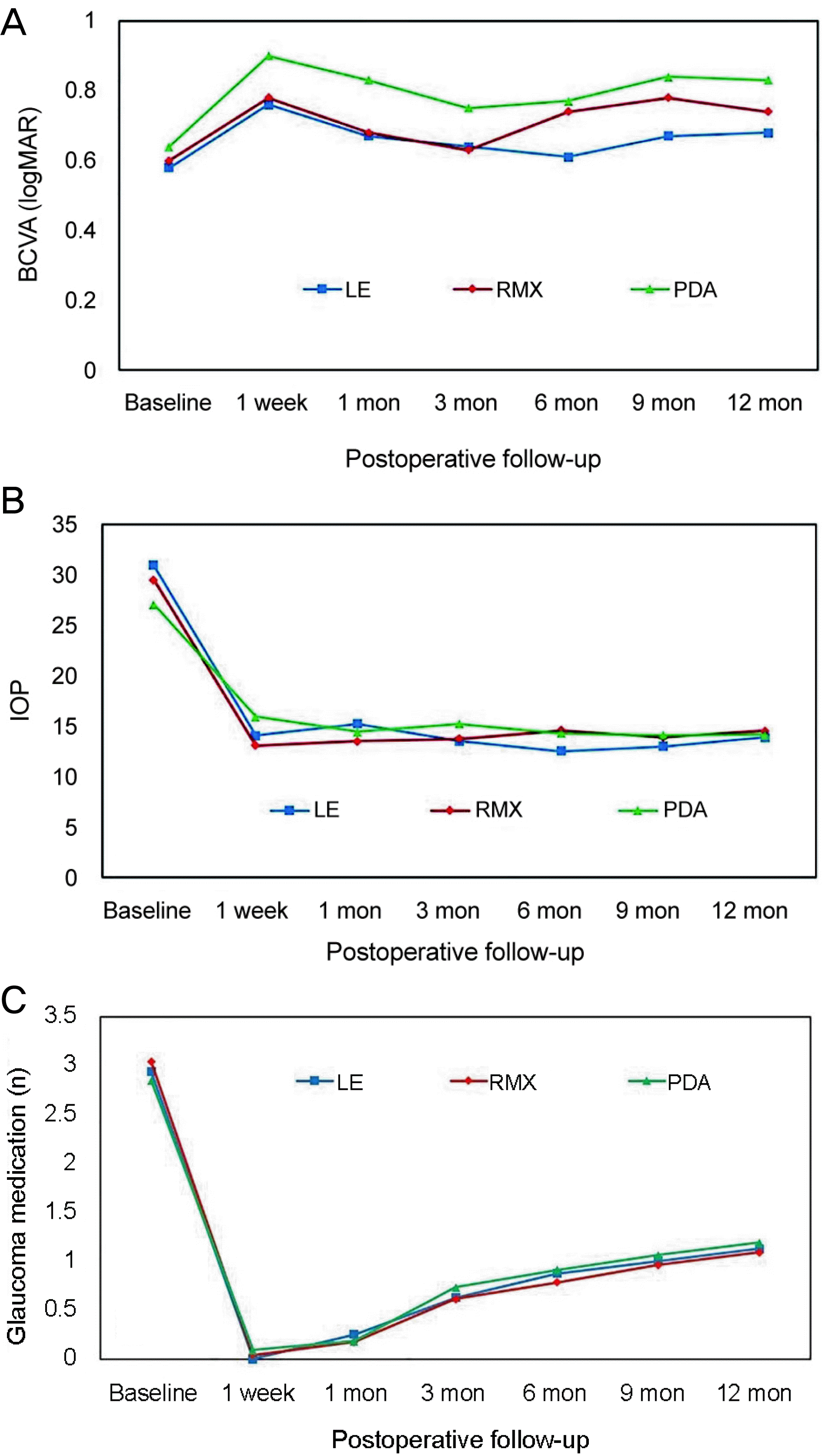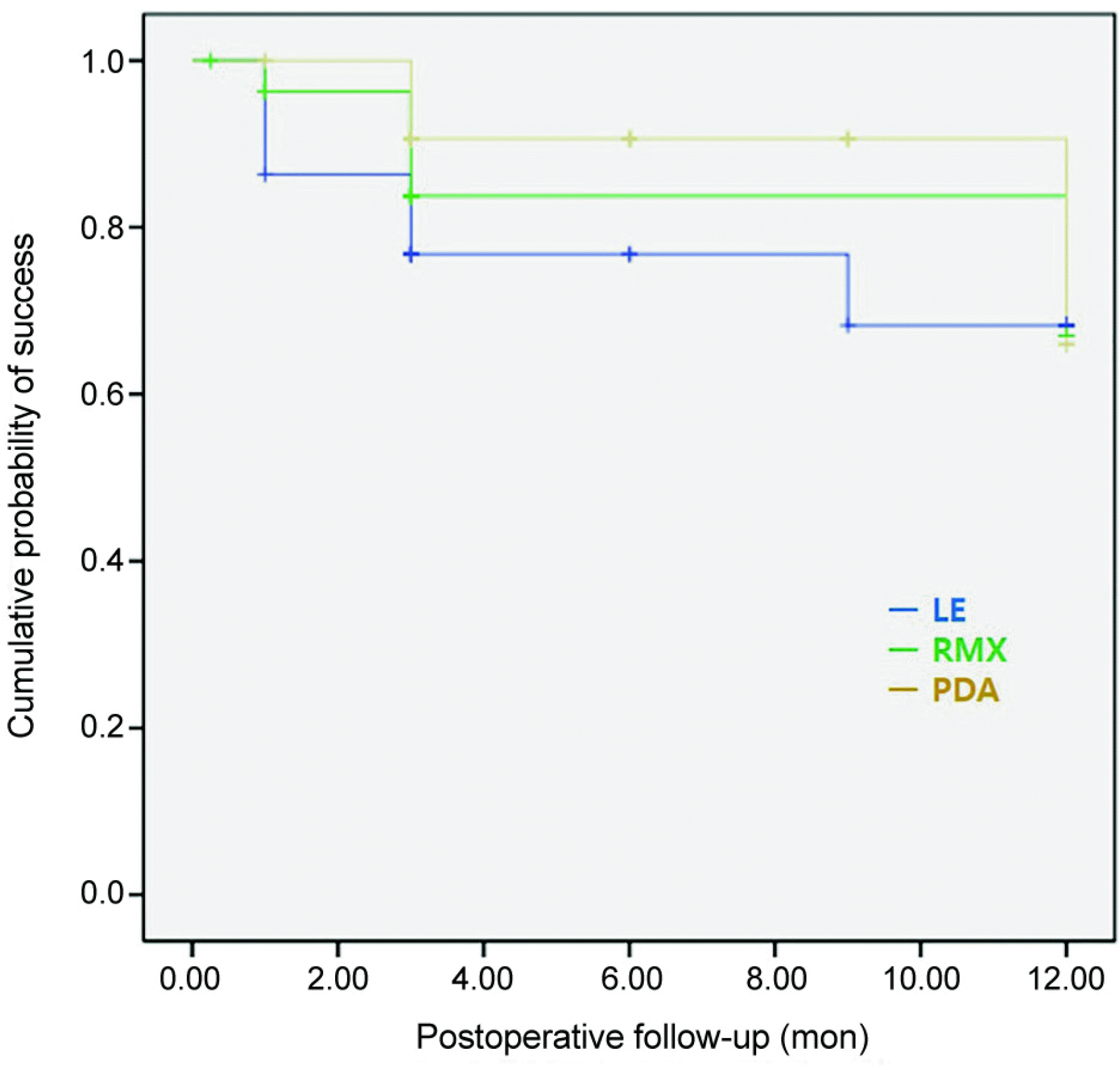Abstract
Purpose
To compare the surgical outcomes and intraocular pressure (IOP) reduction after trabeculectomy in patients with primary open-angle glaucoma (POAG) according to treatment with three different postoperative topical steroids.
Methods
A total of 84 eyes of 84 patients who had undergone trabeculectomy for POAG and were followed-up at least 1 year were included in this study. According to the postoperative topical steroid treatment, the patients were divided into three groups involving 0.5% loteprednol etabonate (LE), 1% rimexolone (RMX), and 1% prednisolone acetate (PDA). The mean IOP change, mean number of topical anti-glaucoma medication changes, 1-year success rate, and complication percentage were compared among the three groups.
Results
There were significant reductions in the IOP and number of anti-glaucoma medications during the postoperative 1-year follow-up in all of the groups (all, p < 0.05), but there were no differences among the three groups. Postoperative 1-year success rates (68.2% in the LE group, 67.0% in the RMX group, and 65.9% in the PDA group; p = 0.88) and complication percentages of trabeculectomy were not significantly different among the three groups.
Go to : 
REFERENCES
1). Friedman DS, Wilson MR, Liebmann JM, et al. An evidence based assessment of risk factors for the progression of ocular hypertension and glaucoma. Am J Ophthalmol. 2004; 138:S19–31.
2). Cairns JE. Trabeculectomy. Preliminary report of a new method. Am J Ophthalmol. 1968; 66:673–9.
3). Khaw PT, Occleston NL, Schultz G, et al. Activation and suppression of fibroblast function. Eye (Lond). 1994; 8(Pt 2):188–95.

4). Hu CY, Matsuo H, Tomita G, et al. Clinical characteristics and leakage of functioning blebs after trabeculectomy with mitomycin-C in primary glaucoma patients. Ophthalmology. 2003; 110:345–52.

5). Sugar HS. Clinical effect of corticosteroids on conjunctival filtering blebs; a case report. Am J Ophthalmol. 1965; 59:854–60.
6). Nguyen KD, Lee DA. Effect of steroids and nonsteroidal anti-inflammatory agents on human ocular fibroblast. Invest Ophthalmol Vis Sci. 1992; 33:2693–701.
7). Araujo SV, Spaeth GL, Roth SM, Starita RJ. A ten-year follow-up on a prospective, randomized trial of postoperative corticosteroids after trabeculectomy. Ophthalmology. 1995; 102:1753–9.

8). Starita RJ, Fellman RL, Spaeth GL, et al. Short-and long-term effects of postoperative corticosteroids on trabeculectomy. Ophthalmology. 1985; 92:938–46.
9). Amon M, Busin M. Loteprednol etabonate ophthalmic suspension 0.5%: efficacy and safety for postoperative anti-inflammatory use. Int Ophthalmol. 2012; 32:507–17.

10). Kavuncu S, Horoz H, Ardagil A, Erbil HH. Rimexolone 1% versus prednisolone acetate in preventing early postoperative inflammation after cataract surgery. Int Ophthalmol. 2008; 28:281–5.

11). Pleyer U, Ursell PG, Rama P. Intraocular pressure effects of common topical steroids for post-cataract inflammation: are they all the same? Ophthalmol Ther. 2013; 2:55–72.

12). Huang P, Shi Y, Wang X, et al. Interocular asymmetry of the visual field defects in newly diagnosed normal-tension glaucoma, primary open-angle glaucoma, and chronic angle-closure glaucoma. J Glaucoma. 2014; 23:455–60.

13). Heuer DK, Barton K, Grehn F, et al. Consensus on definitions of success. Shaarawry TM, Sherwood MB, Grehn F, editors. Guidelines on Design and Reporting of Glaucoma Surgical Trials. 1st. Amsterdam: Kugler publications;2009. chap. 2.
14). Palanca-Capistrano AM, Hall J, Cantor LB, et al. Long-term outcomes of intraoperative 5-fluorouracil versus intraoperative mitomycin C in primary trabeculectomy surgery. Ophthalmology. 2009; 116:185–90.

15). Skuta GL, Parrish RK 2nd. Wound healing in glaucoma filtering surgery. Surv Ophthalmol. 1987; 32:149–70.

16). Palmer SS. Mitomycin as adjunct chemotherapy with trabeculectomy. Ophthalmology. 1991; 98:317–21.

17). Kang SH, Kim JW. Effects of prednisolone and loteprednol eyedrops on the proliferation of human tenon's capsule fibroblasts. J Korean Ophthalmol Soc. 2013; 54:1423–8.

18). Yuki K, Shiba D, Kimura I, et al. Trabeculectomy with or without intraoperative sub-tenon injection of triamcinolone acetonide in treating secondary glaucoma. Am J Ophthalmol. 2009; 147:1055–60. 1060.e1-2

19). Holland EJ, Djalilian AR, Sanderson JP. Attenuation of ocular hypertension with the use of topical loteprednol etabonate 0.5% in steroid responders after corneal transplantation. Cornea. 2009; 28:1139–43.

20). Thomas R, Jay JL. Raised intraocular pressure with topical steroids after trabeculectomy. Graefes Arch Clin Exp Ophthalmol. 1988; 226:337–40.

21). Wilensky JT, Snyder D, Gieser D. Steroid-induced ocular hypertension in patients with filtering blebs. Ophthalmology. 1980; 87:240–4.

22). Spaeth GL, Joseph NH, Fernandes E. Trabeculectomy: a reevaluation after three years and a comparison with Scheie's procedure. Trans Sect Ophthalmol Am Acad Ophthalmol Otolaryngol. 1975; 79:OP349–61.
23). Foster CS, Alter G, DeBarge LR, et al. Efficacy and safety of rimexolone 1% ophthalmic suspension vs 1% prednisolone acetate in the treatment of uveitis. Am J Ophthalmol. 1996; 122:171–82.
24). Loteprednol Etabonate US Uveitis Study Group. Controlled evaluation of loteprednol etabonate and prednisolone acetate in the treatment of acute anterior uveitis. Am J Ophthalmol. 1999; 127:537–44.
Go to : 
 | Figure 1.The changes in best corrected visual acuity (BCVA), intraocular pressure (IOP), and mean number of anti-glaucoma medication in the three groups during the 1-year follow-up. (A) BCVA was remained stable during the follow-up in the three groups. (B, C) IOP and mean number of glaucoma medication were significantly reduced after trabeculectomy through the 1-year follow up. There were no significant differences in BCVA, IOP, or mean number of glaucoma medication among the three groups. mon = month(s); LE = loteprednol etabonate; RMX = rimexolone; PDA = prednisolone acetate. |
 | Figure 2.Cumulative probabilities of success of trabeculectomy in the three groups. The success rates at 1 year was 68.2% in loteprednol etabonate (LE) group, 67.0% in rimexolone (RMX) group, and 65.9% in prednisolone acetate (PDA) Group, which was not significantly different among the three groups (p = 0.877, log-rank test). mon = month(s). |
Table 1.
Demographic and baseline characteristics of the three groups
| LE | RMX | PDA | p-value | |
|---|---|---|---|---|
| Number of patients/eyes | 22/22 | 28/28 | 34/34 | - |
| Age (years)* | 60.25 ± 11.51 | 58.91 ± 17.01 | 61.26 ± 14.97 | 0.721 |
| Sex (male:female)† | 11:11 | 19:9 | 20:14 | 0.438 |
| BCVA (logMAR)* | 0.58 ± 0.89 | 0.60 ± 0.98 | 0.64 ± 1.05 | 0.744 |
| IOP (mmHg)* | 30.94 ± 8.95 (20–41) | 29.52 ± 7.75 (18–37) | 27.07 ± 7.23 (19–36) | 0.272 |
| Glaucoma medication (n)* | 2.94 ± 0.44 | 3.04 ± 0.37 | 2.85 ± 0.46 | 0.312 |
| Visual field | ||||
| MD (dB)* | −18.58 ± 8.64 | −24.83 ± 7.08 | −18.84 ± 8.96 | 0.605 |
| PSD (dB)* | 8.92 ± 3.24 | 8.32 ± 4.22 | 8.15 ± 4.67 | 0.879 |
| Cup-to-disc ratio* | 0.81 ± 0.07 | 0.85 ± 0.11 | 0.86 ± 0.07 | 0.818 |
| Corneal ECC (cells/mm2)* | 2,355.88 ± 353.41 | 2,250.70 ± 581.57 | 2,087.08 ± 616.03 | 0.316 |
Table 2.
Postoperative interventions and complications in the three groups
| LE (n = 22) | RMX (n = 28) | PDA (n = 34) | p-value* | |
|---|---|---|---|---|
| Interventions (eyes, [n, %]) | ||||
| Releasable suture removal | 22 (100) | 28 (100) | 34 (100) | 0.99 |
| 5-FU augmented needling | 4(18.2) | 4 (14.3) | 5 (14.7) | 0.21 |
| Complications (eyes, [n, %]) | ||||
| Hypotony | 4(18.2) | 4 (14.3) | 4 (11.8) | 0.16 |
| Bleb leakage | 2 (0.09) | 2 (0.07) | 1 (0.03) | 0.34 |
| Bleb infection | 0 (0) | 0 (0) | 0 (0) | 0.99 |
| Choroidal effusion | 1 (4.5) | 1 (3.5) | 2 (5.9) | 0.67 |




 PDF
PDF ePub
ePub Citation
Citation Print
Print


 XML Download
XML Download